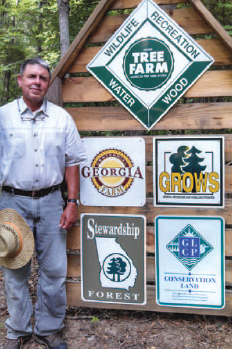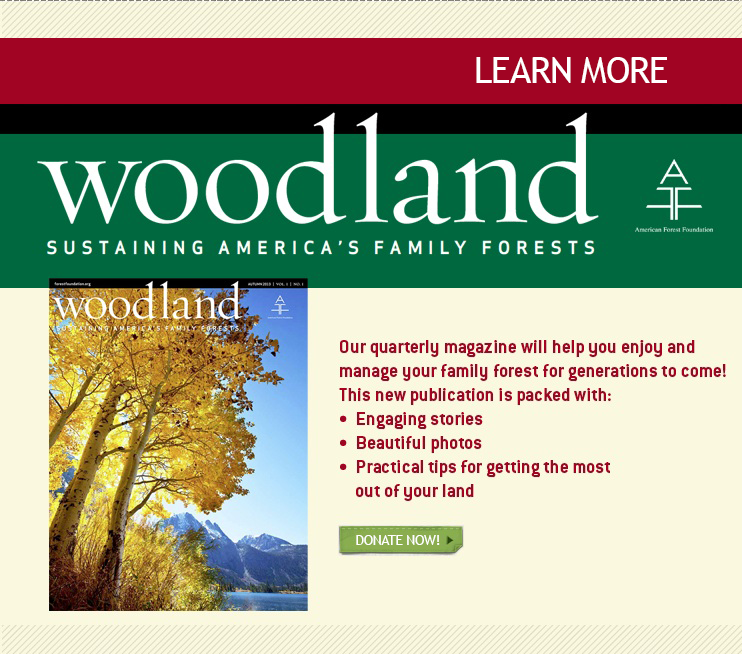The Many Benefits of Conservation Easements

- By Kathy Westra
We may not be able to avoid death or taxes, but there is a powerful tool available to Tree Farmers that provides some measure of immortality and often tax relief, too. That tool is a legal agreement known as a conservation easement, which helps ensure Tree Farmers’ hopes and dreams for their family land—and their woodland stewardship practices—will endure long after they are gone.
“Tree Farmers practice a stewardship ethic of managing for wood, water, wildlife and recreation,” says Tree Farmer John Bembry of Georgia (right), who has placed part of his Tree Farm, Bembry’s Mill, and other property he owns, under easement. “A conservation easement assures that your stewardship will continue."
”So what is a conservation easement and how does it work? “An easement is a voluntary legal agreement that establishes certain restrictions on land use to guide the management of the property in the future,” says Connie Best, co-founder and co-CEO of the Pacific Forest Trust and vice chair of the American Forest Foundation (AFF) board of directors. “It grants the administration of these restrictions to a land trust or a government agency, which is then responsible for making sure the agreement is honored."
”What’s important, says Best, “is that the landowner is in the driver’s seat. The land trust, or whoever holds the easement, is responsible for carrying out the landowner’s wishes and making sure those commitments are honored through future generations.”
In Bembry’s case, the 150-acre easement he donated to the Georgia Forestry Commission allows him and his family to continue to live and work on the Tree Farm, and to build one additional home for a family member on the parcel. “The agency that holds the easement has an obligation in perpetuity to make sure the easement is not violated, ”Bembry explains. “If we planted non-native species or attempted to build more than one home or decided to undertake open-pit mining, that would violate the terms of the easement, which is very definitive in terms of what’s allowed and what’s not."
”There are many motivations for forest owners to seek easements on their land, Best notes. “Wanting to keep forests as forest and keep forest properties in the family are the main drivers for most landowners considering easements. They’ve realized they’re not getting any younger and they’re thinking about the future of their land. Or maybe they’re seeing encroaching development and realize that if they’re not thinking today about ways to keep their forests viable for the future, tomorrow they may be too late.
”Tax considerations drive many private woodland owners to seek easements. Placing land in a conservation easement can ease tax burdens during the landowner’s lifetime. By eliminating development options that a Tree Farmer doesn’t want, a conservation easement can reduce the market value of the land, and with that the owner’s property tax and estate tax bills. If the easement is granted as a charitable gift, there can potentially be significant income tax deductions (and, in some states, tax credits), too.
In addition to benefiting landowners, conservation easements offer significant ecological benefits. “If we don’t have unfragmented, undeveloped forestland, there’s no future to our industry,” says Jamey French, the CEO of Northland Forest Products, a wood products company in Kingston, New Hampshire. “Just like we need working agricultural lands to feed our families in the future, we need working forests to provide things like clean water, clean air, wildlife habitat and carbon sequestration,” says French, who also serves as vice chair of the Land Trust Alliance (LTA), an umbrella organization representing more than 1,700 local and regional land trusts that partners with AFF on efforts to conserve forests.
The key, says French, is having a long-term vision for the land, rather than a focus on short-term profits. “It’s a courageous step for people to be willing to give up immediate value in order to protect these values long-term.”
“Easements can help align with state forest action plans around places that matter—places of significance like Wisconsin’s Driftless Area, the longleaf Piney Woods of the Southeast, and New England’s North Woods—to assure they’re protected in perpetuity,” says Bettina Ring, AFF’s senior vice president for family forests. “We are working with individual landowners in those places as a way to protect these larger ecosystems. We identify the landscapes that need to be conserved and then work with land trust partners who contribute by holding working forest easements."
”In New England, the American Forest Foundation has been working with a regional land trust, the New England Forestry Foundation, to conduct researchon the barriers that prevent family forest owners from using easements to manage and conserve their land. “We’re also examining where easements are working and where they’re not,” Ring says.
Easements, she says, “are just one of the many tools available in the toolbox for private landowners who want to keep their forests in the family. They’re a tool that works for some, not for others.” To learn whether an easement is right for your family and your land, French suggests you get to know the people at a local land trust and learn about all the different options they offer to help you protect your family’s property (see the sidebar below for information on how to find local land trusts). “Your local land trust will help you put together an agreement that works best for your needs,” he says.
“We’ve seen a big increase in the use of conservation easements since we first started doing this 20 years ago, when it was a very novel approach,” says Best. “Tree Farmers have a big investment in the stewardship of their property and they want some continuity in their management vision. The conservation easement becomes a vehicle for expressing a family’s land ethic and guiding their forestry over time.”
LANDOWNER RESOURCES ON CONSERVATION EASEMENTS
If you’re intrigued by the idea of protecting your land through a conservation easement, many resources are available to guide you through the process. Here are a few to get you started:
• My Land Plan has a good overview and links for further information: http://mylandplan.org/conservation-easement.
• Your financial advisor can help you determine the tax benefits of placing all or some of your land under easement.
• Your local or regional land trust can help you draw up a legally binding easement, while assuring that you and your family can continue to live and work on your land.The Land Trust Alliance (LTA) maintains a national database of more than 1,700 local and regional land trusts at http://findalandtrust.org.
• Some land trusts exist for the explicit purpose of conserving forests and other working lands. These include the Small Woodland Owners Association of Maine Land Trust, the New England Forestry Foundation, the Society for the Protection of New Hampshire Forests, the Driftless Area Land Conservancy, the Alabama Forest Resources Center, and the Pacific Forest Trust.
• The American Forest Foundation and World Resources Institute have published an informative report, “Gaining Ground: Increasing Conservation Easements in the U.S.South,” that includes a discussion of the benefits of an easement. While the focus is on the South, the basic information is valuable to all woodland owners. Find it at http://www.wri.org/sites/default/files/pdf/gaining_ground.pdf.
• The LTA website has a primer on conservation easements for landowners at www.landtrustalliance.org/conservation/landowners/conservation-easements.










Comments: